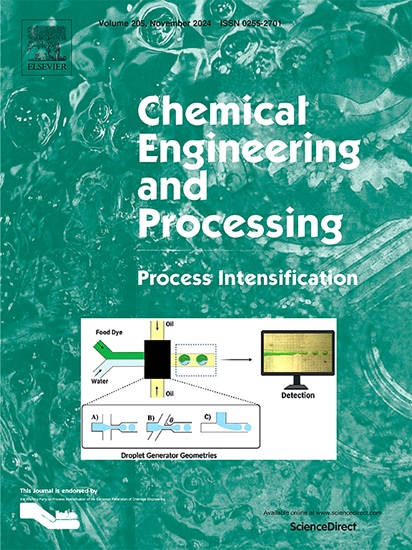CFD modelling of simultaneous extraction and stripping of rare earth metals in a hollow fiber supported liquid membrane
IF 3.8
3区 工程技术
Q3 ENERGY & FUELS
Chemical Engineering and Processing - Process Intensification
Pub Date : 2025-06-27
DOI:10.1016/j.cep.2025.110425
引用次数: 0
Abstract
Nickel Metal Hydride batteries are used in many electronic devices. These batteries contain trace amounts of rare earth metals such as neodymium and lanthanum, which can be extracted from spent batteries and repurposed. Hollow fiber supported liquid membrane (HFSLM) systems have emerged as a promising alternative to the conventional solvent extraction methods, when dealing with low metal concentrations in solution. Hence, a Computational Fluid Dynamics (CFD) model has been developed to study extraction only, and simultaneous extraction-stripping of two rare earth metals (lanthanum and neodymium) in a HFSLM, using Cyanex 272 as the carrier. The equilibrium constants were obtained from experiments, for the extraction only study, and were considered as a fitting parameter for the extraction-stripping study. The metal transport from aqueous to organic solution was modelled based on the distribution coefficient, where it has been incorporated as an evolving parameter, which keeps changing along the length of the membrane. The Navier-Stokes equation and the species transport equation were coupled, and solved simultaneously to obtain the concentration distributions of La+3, Nd+3, and H+. The proposed model has been validated with experiments. During simultaneous extraction-stripping, the overall recovery is governed by the rate at which the complex diffuses through the membrane, and also the rate at which decomplexation takes during the stripping process. The suggested CFD model will be beneficial in both the design and scale-up of HFSLM for the separation of metal ions by modifying the design and process parameters. The model is generic in nature and hence any system with different transport properties can also be simulated using this model.

中空纤维支撑液膜中稀土金属同时萃取和剥离的CFD模拟
镍金属氢化物电池用于许多电子设备。这些电池含有微量的稀土金属,如钕和镧,这些金属可以从废电池中提取并重新利用。中空纤维支撑液膜(HFSLM)系统已成为传统溶剂萃取方法的一种有前途的替代方法,用于处理溶液中低浓度的金属。因此,建立了计算流体动力学(CFD)模型,研究了以cyanex272为载体的HFSLM中两种稀土金属(镧和钕)的提取和同时提取-剥离。平衡常数由实验得到,仅用于提取研究,并被认为是提取-剥离研究的拟合参数。金属从水溶液到有机溶液的传输是基于分布系数建模的,其中它已被纳入一个不断变化的参数,该参数沿着膜的长度不断变化。将Navier-Stokes方程与物质输运方程耦合求解,得到La+3、Nd+3和H+的浓度分布。通过实验验证了该模型的有效性。在同时提取-溶出过程中,总回收率由络合物通过膜扩散的速率和溶出过程中解复的速率决定。所建立的CFD模型通过对设计参数和工艺参数的修改,将有利于金属离子分离的HFSLM的设计和放大。该模型本质上是通用的,因此任何具有不同输运性质的系统都可以使用该模型进行模拟。
本文章由计算机程序翻译,如有差异,请以英文原文为准。
求助全文
约1分钟内获得全文
求助全文
来源期刊
CiteScore
7.80
自引率
9.30%
发文量
408
审稿时长
49 days
期刊介绍:
Chemical Engineering and Processing: Process Intensification is intended for practicing researchers in industry and academia, working in the field of Process Engineering and related to the subject of Process Intensification.Articles published in the Journal demonstrate how novel discoveries, developments and theories in the field of Process Engineering and in particular Process Intensification may be used for analysis and design of innovative equipment and processing methods with substantially improved sustainability, efficiency and environmental performance.

 求助内容:
求助内容: 应助结果提醒方式:
应助结果提醒方式:


